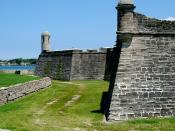- -
St . Augustine , A Tourism Destination
Introduction
St. Augustine, North America's oldest city, rests on the edge of the Atlantic Ocean in Northeast Florida. This historic landmark lies with in close proximity to three of Florida's main cities. Jacksonville is a short thirty minute drive to the north, Daytona is a one hour drive to the south and a two hour drive to the southwest will put you in or around the Orlando area. Approximately two and one half miles off of St. Augustine's coast there is a large ocean current, the Gulf Stream, that played an important part in the settlement of the area. As a member of Florida's First Coast, St. Augustine has twenty four miles of beautiful beaches that offer a plethora of recreational activities. This aspect is a perfect complement to any town involved in the tourism industry.
The topography of the area is consistent with the associations of any coastal town in Northeast Florida.
The city is bound by three different waterways. To the west of the city lies the St. Johns River, while to the east is the Intercoastal Waterway which empties into the Atlantic Ocean providing a natural inlet and bay for passing boats. Off shooting the rivers and waterways there are vast rich wetlands, estuaries and tidal marshes. Indigenous to the area, large moss draped oaks provide a shaded canopy that is a perfect place to picnic, play or just sit and relax. Just over the Intercoastal and the famous Bridge of Lions, is Anastasia Island and the beaches of St. Augustine. Thick hammocks of palmetto, sea oaks, sable palms and sea oats grow wild along the seemingly never-ending coastline, while twenty foot dunes protect the island from extensive erosion damage. The hard packed sand beaches are blanketed with...


